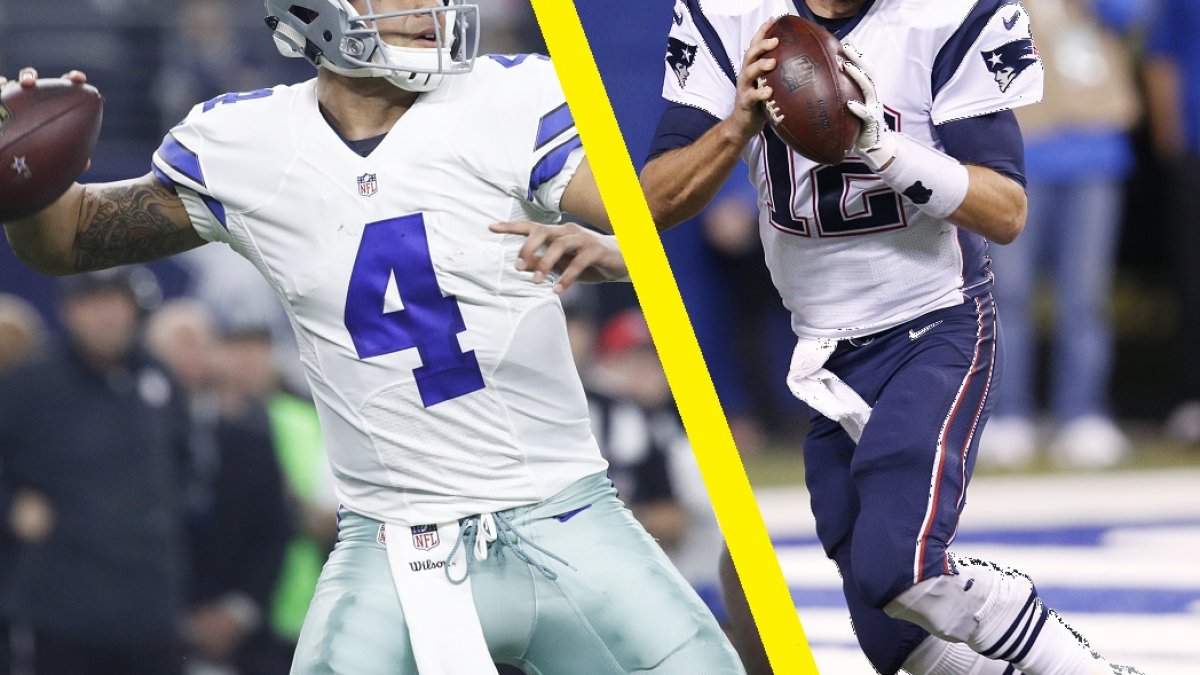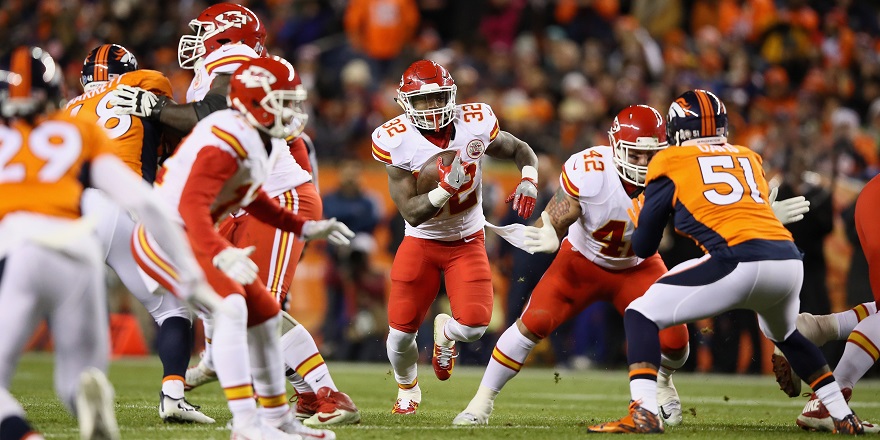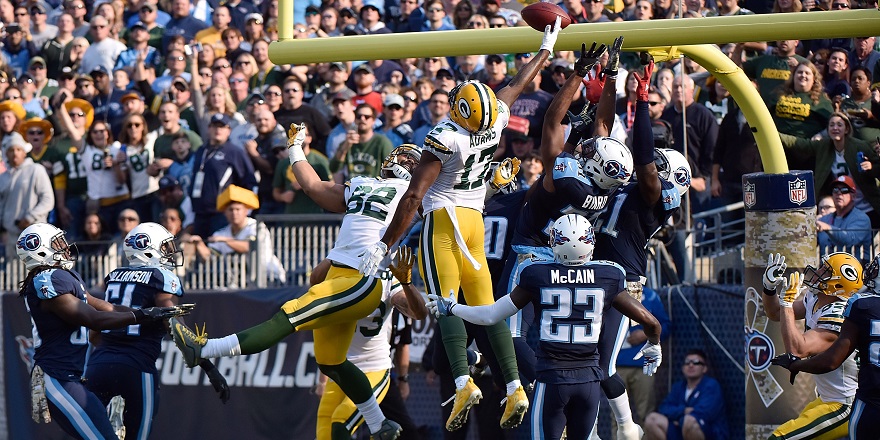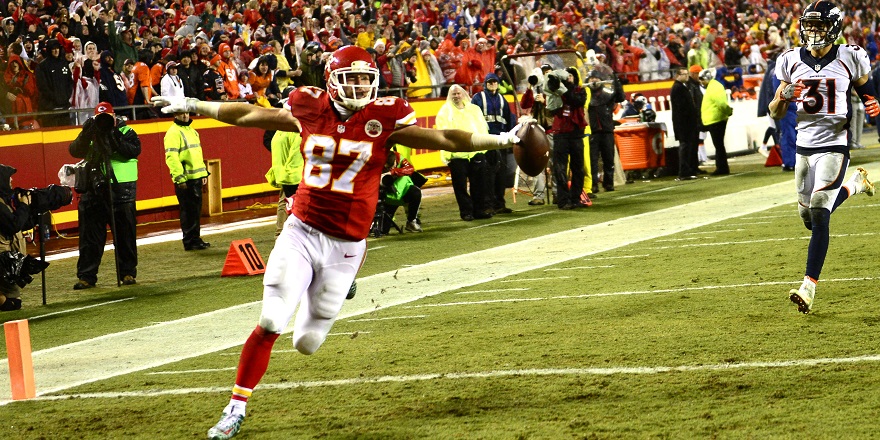Strategy. Knowing why you should make a choice is how you will win your draft and ultimately win your league. It’s time to answer some real strategy questions.
Why should you wait to take a quarterback and for how long? How about some real-life examples? Should I take a lead back if a rookie is biting at his heels and is a legitimate threat to his playing time? Is a No. 1 wide receiver on a bad offense as good or better than a No. 2 wide receiver on a good offense? Can I rely on tight end production enough to feel good about taking one early, or should I wait and stream the best option each week?
Average draft position numbers are meaningless if you don’t put those numbers in context and make some logical decisions utilizing that data. Our friends over at Fantasy Football Calculator gave us some ADP data and it all boils down to the classic question: This or that?
Quarterbacks — early or late
This: Tom Brady 3.03 and a ninth-round pick
Last year, Brady’s 99.3 PFF player grade was the highest among all players at every position. He threw for 3,554 yards, 28 touchdowns and only two interceptions over the course of 12 regular-season games. He’s successful because he gets the ball out of his hands. It takes him an average of 2.49 seconds to throw, the eighth-fastest among quarterbacks who played in at least 50 percent of their teams’ snaps. Kept clean, he has an 83.2 adjusted completion percentage, second-best in the league. Under pressure he’s at 68.1 percent, fifth-best. History tells us not to bet against Tom Brady. You’ll lose. However, Father Time is undefeated. Wheat grass shots help, but Brady will turn 40 years old in August. Is this the year when we see a sharp decline in Brady’s skillset? It happens, and most recently to his football rival, Peyton Manning. In 2013, Manning broke the single-season yards (5,477) and touchdown (55) records. In 2014, he dropped to 4,733 yards and 39 touchdowns, still a top-five fantasy option at the position. In 2015 at the age of 39, Manning put up 2,249 yards and nine touchdowns (while throwing 17 interceptions). Taking a quarterback in the early rounds is risky, but Brady’s performance in 2016 was superb and if you think he’s pulling a Benjamin Button, you may even think he’s a steal.
Ninth-round possible pairings: Jonathan Stewart, Carolina Panthers; Jeremy Hill, Cincinnati Bengals; Kareem Hunt, Kansas City Chiefs; Matt Forte, New York Jets; Thomas Rawls, Seattle Seahawks; Jeremy Maclin, Baltimore Ravens; Corey Coleman, Cleveland Browns; Kyle Rudolph, Minnesota Vikings
Best pairing: Kyle Rudolph – He has the clearest role on his team out of the ninth-round options and his 120 targets, 83 catches, and seven touchdowns the second highest among tight ends last season.
Or that: Dak Prescott at 9.02 and a third-round pick
The biggest knock on Prescott going into the 2017 season will be the small sample size. After entering the league as a fourth-round pick out of Mississippi State, the expectations were low when he took over for Tony Romo after a (turned out to be) career-ending back injury. To say that Prescott exceeded those expectations would be a gross understatement. Prescott scored an average of 0.58 fantasy points per dropback, second only to Matt Ryan. His 75.3 accuracy percentage was the 10th-best in the league among the quarterbacks who played in at least 50 percent of their teams’ snaps. He threw 23 touchdowns while only throwing four interceptions. His six rushing touchdowns tied with Tyrod Taylor for the most in the league, despite carrying the ball 37 fewer times. His ability to move on his feet extends to his use of play action. 24.2 percent of his plays were play action (second-most in the league only to Ryan) and he completed 75.7 percent of those pass attempts, none of which resulted in an interception. Defenses didn’t have a whole year of tape on Prescott last season, but when a player combines athleticism with accuracy, you should sit up and take notice.
Third-round possible pairs: Isaiah Crowell, Cleveland Browns; Christian McCaffrey, Carolina Panthers; Spencer Ware, Kansas City Chiefs; Carlos Hyde, San Francisco 49ers; Joe Mixon, Cincinnati Bengals; Brandin Cooks, New England Patriots; DeAndre Hopkins, Houston Texans; Doug Baldwin, Seattle Seahawks; Alshon Jeffery, Philadelphia Eagles; Terrelle Pryor, Washington Redskins; Allen Robinson, Jacksonville Jaguars
Best pairing: DeAndre Hopkins – This is splitting hairs, because the elite upside at the wide receiver position in the third round seems to be ridiculous, but Hopkins’ likely volume puts him over the top. Last season his 138 targets were the 11th-most in the league, but the Brock Osweiler led offense’s fits-and-starts torpedoed Hopkins’ value. Look for that to change in 2017.
Conclusion:
Brady was suspended for the first four games of the 2016 season. Prescott technically started in Week 17, but only played in 15 of the team’s offensive snaps. The fairest way to assess their performances was to consider fantasy points scored from Week 5 to Week 16 (both players had a bye in that time). Over the course of 11 games, Brady scored 233 fantasy points in standard scoring, while Prescott scored 222 points. Therefore, Prescott averaged exactly one fewer point per game than Brady. Considering the Round 3 players’ stability of usage as compared to the Round 9 options, waiting and selecting Prescott makes sense and a clear-cut example of why many ascribe to the late-found quarterback philosophy.
Running backs — old or new
This: Spencer Ware at 3.08
Jamaal Charles never got healthy in 2016, so the lead-back role in the RB-friendly Andy Reid offense was his for the taking. Unfortunately, after a strong start, things didn’t pan out for Ware. Rarely do you see a running back who starts the season with back-to-back 100-yard games, only to score two total touchdowns and put up zero 100-yard performances during the last eight games of the regular season. Over the course of the entire 2016 season, Ware averaged 4.3 yards per carry, but from Week 10 to 16 he averaged 3.7 yards per carry, 48th in the league. More importantly, Ware’s performance changed the way Andy Reid runs an offense. Last season, the Kansas City Chiefs ran on 43.01 percent of their offensive plays. In 2015, they ran on 47.96 percent. Prior to his second ACL injury, Charles was the definition of a three-down back. Reid’s offenses normally run through the running back. Prior to Charles, it was LeSean McCoy and Brian Westbrook in Philadelphia. Frankly, there is a good chance that rookie Kareem Hunt from Toledo is more of the three-down back that Reid is accustomed to. During the offseason, Reid praised Ware for his toughness, but then they drafted Hunt, who impressed during OTAs. There’s a lot of uncertainly. Look at the other running back options going off the board around the same time as Ware, and notice how many of them are the lead backs projected to have a lot of touches. Volume is key when you select a running back, and at this point, it’s hard to project Ware at any more than a fantasy equal with Hunt.
Other running back options around his ADP: Todd Gurley, Los Angeles Rams; Lamar Miller, Houston Texans; Isaiah Crowell, Cleveland Browns; Christian McCaffrey, Carolina Panthers; Carlos Hyde, San Francisco 49ers; Joe Mixon, Cincinnati Bengals; Adrian Peterson, New Orleans Saints; Doug Martin, Tampa Bay Buccaneers
Or that: Kareem Hunt at 9.06
Who exactly is Hunt? According to the folks analyzing college ball here at PFF, Hunt was the sixth-best running back prospect entering the league this year. He’s was one of the most elusive backs, with 176 missed tackles over three seasons at Toledo. He was not tackled on first contact 42.4 percent of the time, the second highest in the class. Over the course of his college career he averaged 6.3 yards per carry and fumbled only once on 722 total touches. During his last year at Toledo, Hunt caught 41 passes for 403 yards, which was the 10th most receiving yards out of all the running backs in the NFL last season. Hunt can be a three-down back and it’s going to be difficult to keep him on the sidelines, especially if he flashes in the preseason games.
Other running back options around his ADP: Jamaal Charles, Denver Broncos; Danny Woodhead, Baltimore Ravens; Jonathan Stewart, Carolina Panthers; Jeremy Hill, Cincinnati Bengals; Matt Forte, New York Jets; Thomas Rawls, Seattle Seahawks; Terrance West, Baltimore Ravens; Theo Riddick, Detroit Lions
Conclusion:
The running backs going off the board in the ninth round do not have the upside that Hunt possesses. Going for stability and for players with a clear role in their offense during the first eight rounds and then targeting players with upside from Round 9 forward is a winning strategy. In the interest of transparency (and to further the conversation about fantasy football strategy and technique), I will let you in on my rule: I do not put more than $10 in on any league that drafts before August 1. This running back situation is a prime example as to why. The vulnerability in this running back friendly offense throws a wrench into analyzing their value this early in the preseason. By the time August rolls around, this situation will become clearer and the ADPs will follow suit.
Wide receivers — high-end No. 2 or low-end No. 1
This: Davante Adams at 4.01
Last year, Adams caught 75 passes for 997 yards and 12 touchdowns. Sure, it’s not difficult to believe in when a player is catching balls thrown by Aaron Rodgers, but Adams’ average 5.4 yards after the catch was impressive, and ranked sixth among wideouts with at least 100 aimed targets. Taking Adams early isn’t really a leap of faith, although one would have to believe that Randall Cobb’s tenure as the No. 2 option is officially over in order to go for Adams that early.
But what about all the No.1 wide receivers going off the board later (sometimes much later) in fantasy drafts? Does this make sense? Well, the answer is both yes and no. No. 1 wide receivers have a much higher rate of 1,000-plus yard yearly performances and double-digit touchdowns. Last season, 16 teams saw at least a 30 percent drop in yardage when comparing the No. 1 wideout to the No. 2 wideout on the team. The biggest drop in yardage was in Indianapolis, where there was a 63.54 percent decrease from T.Y. Hilton to Phillip Dorsett. Yes, Dorsett had the second most yards on the Colts in 2016. Only one team in the NFL supported two wide receivers with double-digit touchdowns and it was the Green Bay Packers.
Also, Adams was only three yards shy of 1,000 yards. In 2014, the Packers supported two wide receivers with both 1,000-plus yards and double-digit touchdowns. That year, it was Jordy Nelson and Cobb who made the cut. In terms of yardage, last year only four teams supported two wide receivers with 1,000-plus yards: Denver Broncos, New Orleans Saints, Oakland Raiders, Washington Redskins. Meanwhile, anemic offenses still garnered 1,000-plus yard performances from their No. 1 receiver. Kenny Britt went over 1,000 yards on the Rams. Terrelle Pryor did it on the Browns. Mike Wallace may have the quietest 1,000-yard season in history on the Ravens. Golden Tate in Detroit. Jarvis Landry in Miami. Tyrell Williams on the Chargers. Davante Adams is special because he’s a Packer, on a team with a history of supporting multiple high-end fantasy producers at the wide receiver position. But look at this list below, representing the No. 1 options that are going later in the draft. These players offer volume. This is fantasy football. Volume is king.
No. 1 options below Adams (in order of ADP): Demaryius Thomas, Denver Broncos; Sammy Watkins, Buffalo Bills; Tyreek Hill, Kansas City Chiefs; Keenan Allen, Los Angeles Chargers; Jarvis Landry, Miami Dolphins; Kelvin Benjamin, Carolina Panthers; Larry Fitzgerald, Arizona Cardinals; Golden Tate, Detroit Lions; Stefon Diggs, Minnesota Vikings; Corey Davis, Tennessee Titans; Pierre Garcon, San Francisco 49ers; Jeremy Maclin (and/or Mike Wallace), Baltimore Ravens; Corey Coleman, Cleveland Browns; Cameron Meredith, Chicago Bears; Quincy Enunwa, New York Jets
Or that: Pierre Garcon at 8.11
Along with DeSean Jackson, Garcon was one of the two wide receivers on the Washington Redskins who put up over 1,000 yards last season. Neither of those players is on the team anymore, but it’s Garcon who has the best chance of hitting that mark again because he will be the No. 1 option on the team. Is it the 49ers? Yes. Do they have a quarterback? That’s questionable. But Garcon is coming off a great season, the best he’s had since 2013, a year when he played under then-offensive coordinator Kyle Shanahan. That year, Garcon caught 113 passes for 1,346 yards and Robert Griffin III was the starting quarterback. Shanahan knows how to get the most out of a quarterback and a No. 1 wideout. That connection is vital to a Shanahan offense. And there is virtually no competition for that lead target role. The depth behind Garcon includes Marquise Goodwin, Jeremy Kerley, and Aldrick Robinson. It’s almost unimaginable that a potential volume player like Garcon would be available at the end of the eighth round.
No. 2 (or 3) options above Garcon: Davante Adams (and Randall Cobb), Green Bay Packers; Michael Crabtree, Oakland Raiders; Martavis Bryant, Pittsburgh Steelers; Brandon Marshall, New York Giants; Julian Edelman (or Brandin Cooks), New England Patriots; Donte Moncrief, Indianapolis Colts; Willie Snead, New Orleans Saints; DeSean Jackson, Tampa Bay Buccaneers; Emmanuel Sanders, Denver Broncos; DeVante Parker, Miami Dolphins
Conclusion:
Take both, but lean toward volume every time you make a pick. In most cases, volume relies on being the No. 1 wide receiver on the team. The Aaron Rodgers-led Green Bay Packers have proven to be the exception to the rule year after year. The New Orleans Saints are another example of an offense that can support two strong fantasy wide outs. Otherwise, don’t go for Donte Moncrief over Golden Tate. Don’t go DeVante Parker over Corey Coleman. Over the last five years neither the Colts nor the Dolphins have supported two 1,000-plus yard or double-digit touchdown seasons at the position. It is more likely that the player who sees the most targets on his team will hit pay-dirt rather than a player trying to unseat T.Y. Hilton or Jarvis Landry, two players who have put up 1,000-plus yards in every year of their career save their rookie seasons.
Tight ends — to stream or not to stream
This: Travis Kelce at 4.01
Kelce scored the most fantasy points at the position in both standard and PPR formats last season. He caught 85 passes (fourth-most in the league) for 1,125 yards (most in the league) and four touchdowns. His 6.9-yard average depth per target was at the bottom half of the league among tight ends, but he made up for it by averaging 7.7 yards after the catch, the most among tight ends with at least 30 catches on the season. His 2.21 yards per route run was the third-best among tight ends that played in at least 25 percent of their teams’ offensive snaps. Kelce underwent shoulder surgery over the offseason, but he should be back for training camp. Kelce is as sure of a thing as you can get when you play fantasy football. But is that enough? In most leagues, you only play one tight end, and yet you play two or more running backs and three or more wide receivers. There is a lot of talent at those positions in Round 4, so taking Kelce early means that you are forfeiting talent at positions with more spots to fill.
Other Round 4 Options: Davante Adams, Green Bay Packers; Demaryius Thomas, Denver Broncos; Sammy Watkins, Buffalo Bills; Tyreek Hill, Kansas City Chiefs; Keenan Allen, Los Angeles Chargers; Jarvis Landry, Miami Dolphins; Adrian Peterson, New Orleans Saints; Doug Martin, Tampa Bay Buccaneers; Eddie Lacy, Seattle Seahawks; Drew Brees, New Orleans Saints
Or that: Eric Ebron at 13.06 and Cameron Brate at 13.11
Pairing late-round tight ends and playing the weekly matchups isn’t a new strategy, but it may be one of the more difficult ones to fully embrace. However, if you had paired Ebron and Brate last season and played the matchups, one of those two players outscored Kelce in 11 of the 17 weeks of the regular season. Kelce led tight ends in yardage and averaged 70.31 yards per game, but Ebron averaged 54.69 yards per game, which is approximately a 1.5-point difference per game. Moreover, Kelce may have almost doubled Cameron Brate’s 2016 yardage total, but he scored precisely half the number of touchdowns, and with one more game under his belt. There are some question marks regarding Ebron’s health and whether or not O.J. Howard will run away as the No. 1 tight end in Tampa (although it’s Howard’s blocking that impresses most). These lingering uncertainties are the causes of the very late price tags. The only downside to taking two tight ends back-to-back at this point in the draft is that you’ll miss out on some of the dart throws with upside. It’s a small price to pay when you consider that you already got consistent players earlier in the draft.
Other Round 13 Options: Joe Williams, San Francisco 49ers; Duke Johnson, Cleveland Browns; Jonathan Williams, Buffalo Bills; Sterling Shepard, New York Giants; Josh Doctson, Washington Redskins; Kenny Britt, Cleveland Browns; Ted Ginn Jr., New Orleans Saints; Zay Jones, Buffalo Bills; Carson Palmer, Arizona Cardinals; Blake Bortles, Jacksonville Jaguars; Justin Tucker, Buffalo Bills; Stephen Gostkowski, New England Patriots; Matt Bryant, Atlanta Falcons; Baltimore Defense; Carolina Defense
Conclusion:
Streaming any position can be frustrating, but streaming tight ends can come back to burn you. Even Kelce put up fewer than 35 yards and no touchdowns in five games last season. Taking Kelce early will save you some headaches, but taking a player in the fourth round means that you are relying on that player for every-week production. It’s hard to justify any tight end as an end-all-be all fantasy producer. If you select the right streaming tight end each week, you’ll come out on top if you wait. If you miss, you’re in for a long season. You know what kind of fantasy player you are, and at least now you’ll understand the cost.






 © 2025 PFF - all rights reserved.
© 2025 PFF - all rights reserved.